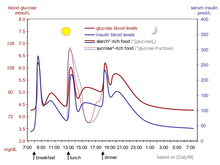
The glycemic (glycaemic) index (GI; /ɡlaɪˈsiːmɪk/[1]) is a number from 0 to 100 assigned to a food, with pure glucose arbitrarily given the value of 100, which represents the relative rise in the blood glucose level two hours after consuming that food.[2] The GI of a specific food depends primarily on the quantity and type of carbohydrate it contains, but is also affected by the amount of entrapment of the carbohydrate molecules within the food, the fat and protein content of the food, the amount of organic acids (or their salts) in the food, and whether it is cooked and, if so, how it is cooked. GI tables, which list many types of foods and their GIs, are available.[3] A food is considered to have a low GI if it is 55 or less; high GI if 70 or more; and mid-range GI if 56 to 69.
The term was introduced in 1981 by David J. Jenkins and co-workers.[4] It is useful for quantifying the relative rapidity with which the body breaks down carbohydrates.[3] It takes into account only the available carbohydrate (total carbohydrate minus fiber) in a food. Glycemic index does not predict an individual's glycemic response to a food, but can be used as a tool to assess the insulin response burden of a food, averaged across a studied population. Individual responses vary greatly.[5]
The glycemic index is usually applied in the context of the quantity of the food and the amount of carbohydrate in the food that is actually consumed. A related measure, the glycemic load (GL),[6] factors this in by multiplying the glycemic index of the food in question by the carbohydrate content of the actual serving.
- ^ "glycaemic index noun". Oxford Learner's Dictionary. Archived from the original on 2017-05-23. Retrieved 2017-05-20.
- ^ "Glycemic Index Defined". Glycemic Research Institute. Archived from the original on 2018-09-27. Retrieved 2012-08-01.
- ^ a b Jenkins, D. J.; Wolever, T. M.; Taylor, R. H.; Barker, H.; Fielden, H.; Baldwin, J. M.; Bowling, A. C.; Newman, H. C.; Jenkins, A. L.; Goff, D. V. (March 1, 1981). "Glycemic index of foods: a physiological basis for carbohydrate exchange". The American Journal of Clinical Nutrition. American Journal of Clinical Nutrition, Volume 34. 34 (3): 362–366. doi:10.1093/ajcn/34.3.362. PMID 6259925. Archived from the original on September 1, 2019. Retrieved January 24, 2020.
- ^ Jenkins, FJ; Wolever, TM; Taylor, RH; Barker, H; Fielden, H; Baldwin, JM; Bowling, AC; Newman, HC; Jenkins, AL; Goff, DF (1981). "Glycemic index of foods: a physiological basis for carbohydrate exchange". Am J Clin Nutr. 34 (3): 362–6. doi:10.1093/ajcn/34.3.362. PMID 6259925. Archived from the original on 2017-07-02. Retrieved 2017-08-24.
- ^ Zeevi, David; Korem, Tal; Zmora, Niv; Israeli, David; Rothschild, Daphna; Weinberger, Adina; Ben-Yacov, Orly; Lador, Dar; Avnit-Sagi, Tali; Lotan-Pompan, Maya; Suez, Jotham; Mahdi, Jemal Ali; Matot, Elad; Malka, Gal; Kosower, Noa; Rein, Michal; Zilberman-Schapira, Gili; Dohnalová, Lenka; Pevsner-Fischer, Meirav; Bikovsky, Rony; Halpern, Zamir; Elinav, Eran; Segal, Eran (2015). "Personalized Nutrition by Prediction of Glycemic Responses". Cell. 163 (5): 1079–94. doi:10.1016/j.cell.2015.11.001. PMID 26590418.
- ^ "Glycemic Load". Avis Regime. Archived from the original on 17 August 2016. Retrieved 12 May 2016.